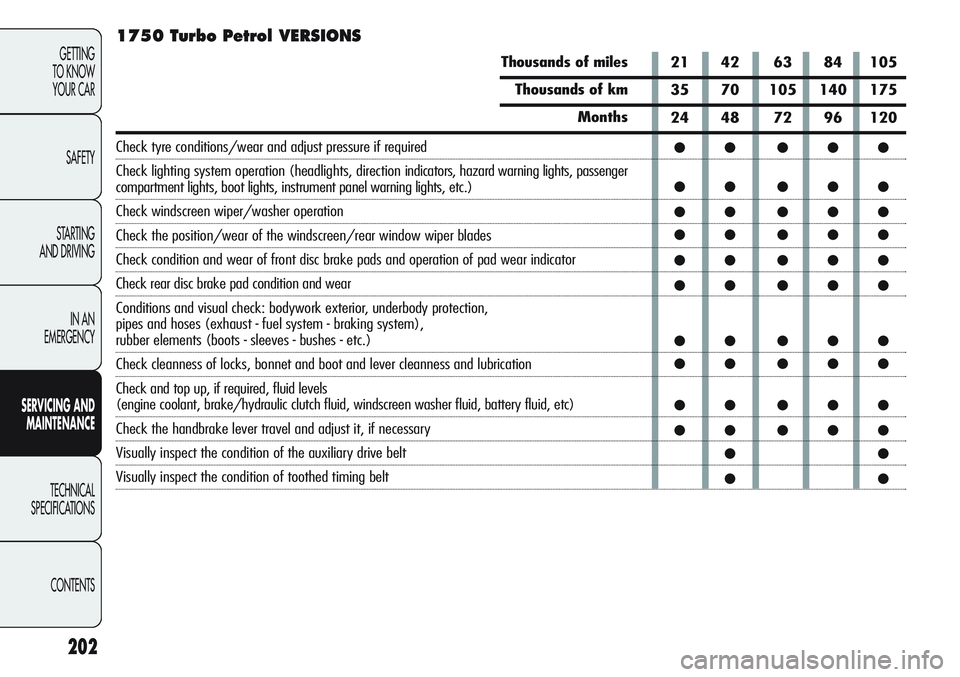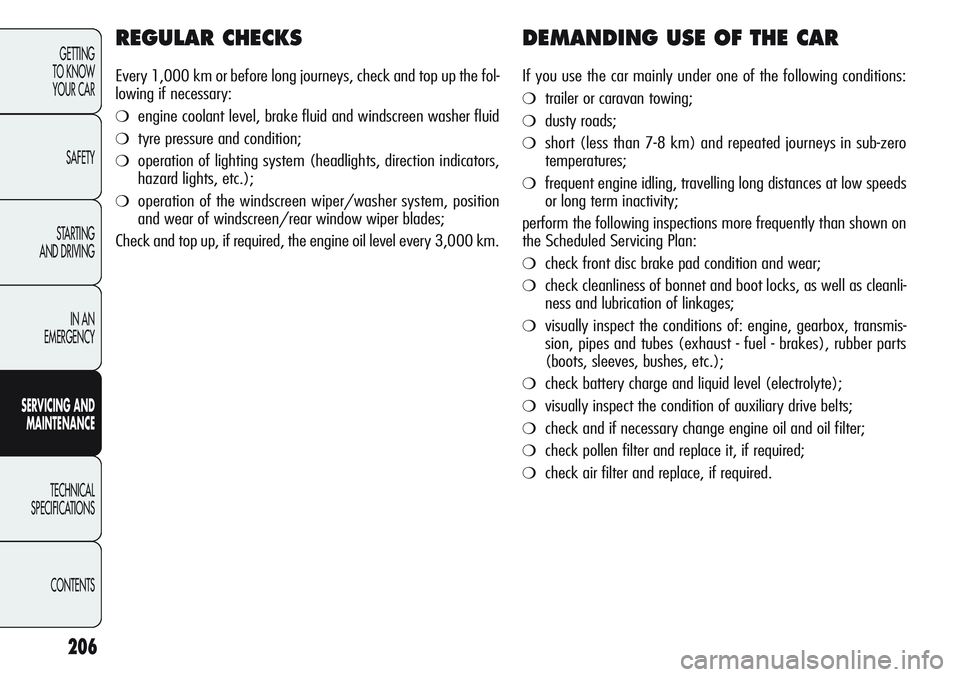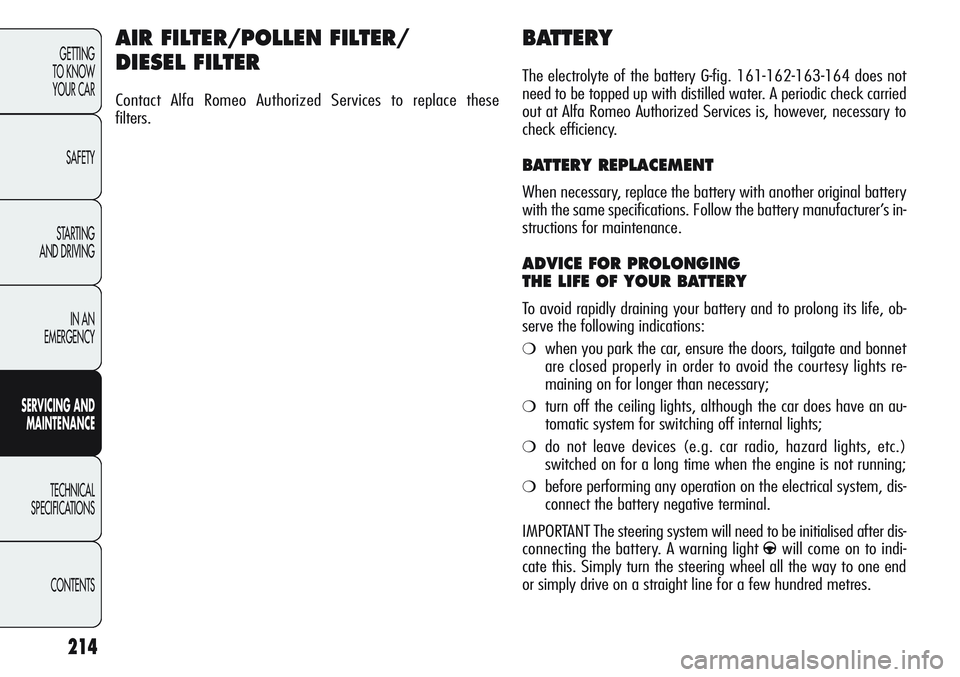light Alfa Romeo Giulietta 2012 Owner handbook (in English)
[x] Cancel search | Manufacturer: ALFA ROMEO, Model Year: 2012, Model line: Giulietta, Model: Alfa Romeo Giulietta 2012Pages: 297, PDF Size: 9.37 MB
Page 204 of 297

200
GETTING
TO KNOW
YOUR CAR
SAFETY
STARTING
AND DRIVING
IN AN
EMERGENCY
SERVICING AND
MAINTENANCE
TECHNICAL
SPECIFICATIONS
CONTENTS
SCHEDULED SERVICING PLAN
1.4 Turbo Petrol and 1.4 Turbo Multi Air VERSIONS
Thousands of miles
Thousands of km
Months
Check tyre condition/wear and adjust pressure if required
Check lighting system operation (headlights, direction indicators, hazard lights, passenger
compartment lights, boot lights, instrument panel warning lights, etc.)
Check windscreen wiper/washer operation
Check the position/wear of the windscreen/rear window wiper blades
Check condition and wear of front disc brake pads and
operation of pad wear indicator
Check rear disc brake pad condition and wear
Conditions and visual check: bodywork exterior, underbody protection,
pipes and hoses (exhaust - fuel system - braking system),
rubber elements (boots - sleeves - bushes - etc.)
Check cleanliness of bonnet and boot locks,
as well as cleanliness and lubrication of linkages
Check and top up, if required, fluid levels
(engine coolant, brake/hydraulic clutch fluid, windscreen washer fluid, battery fluid, etc)
Check the handbrake lever travel and adjust it, if necessary
Check condition of timing belt
Visually inspect the condition of accessory drive belt(s)
Check exhaust gas emissions
Check battery charge status and possibly recharge18 36 54 72 90 108
30 60 90 120 150 180
24 48 72 96 120 144
●●● ●●●
●●● ●●●
●●● ●●●
●●● ●●●
●●● ●●●
●●● ●●●
●●● ●●●
●●● ●●●
●●● ●●●
●●● ●●●
●●
●●
●●● ●●●
●●● ●●●
Page 206 of 297

21 42 63 84 105
35 70 105 140 175
24 48 72 96 120
●● ●●●
●● ●●●
●● ●●●
●● ●●●
●● ●●●
●● ●●●
●● ●●●
●● ●●●
●● ●●●
●● ●●●
●●
●●
202
GETTING
TO KNOW
YOUR CAR
SAFETY
STARTING
AND DRIVING
IN AN
EMERGENCY
SERVICING AND
MAINTENANCE
TECHNICAL
SPECIFICATIONS
CONTENTS
1750 Turbo Petrol VERSIONS
Thousands of miles
Thousands of km
Months
Check tyre conditions/wear and adjust pressure if required
Check lighting system operation (headlights, direction indicators, hazard warning lights, passenger
compartment lights, boot lights, instrument panel warning lights, etc.)
Check windscreen wiper/washer operation
Check the position/wear of the windscreen/rear window wiper blades
Check condition and wear of front disc brake pads and operation of pad wear indicator
Check rear disc brake pad condition and wear
Conditions and visual check: bodywork exterior, underbody protection,
pipes and hoses (exhaust - fuel system - braking system),
rubber elements (boots - sleeves - bushes - etc.)
Check cleanness of locks, bonnet and boot and lever cleanness and lubrication
Check and top up, if required, fluid levels
(engine coolant, brake/hydraulic clutch fluid, windscreen washer fluid, battery fluid, etc)
Check the handbrake lever travel and adjust it, if necessary
Visually inspect the condition of the auxiliary drive belt
Visually inspect the condition of toothed timing belt
Page 207 of 297

203
GETTING
TO KNOW
YOUR CAR
SAFETY
STARTING
AND DRIVING
IN AN
EMERGENCY
SERVICING AND
MAINTENANCE
TECHNICAL
SPECIFICATIONS
CONTENTS
(*) Regardless of the distance covered, the timing belt must be changed every four years for particularly demanding use (cold climates, city driving,
long periods of idling) or at least every five years in all other cases.
(**) The engine oil and the oil filter must be changed when the instrument panel warning light comes on (see “Warning lights and messages” in “Get-
ting to know your car” chapter) or in any case every 12 months.
Thousands of miles
Thousands of km
Months
Check exhaust emissions
Check battery charge status and possibly recharge
Check engine control system operation (via diagnostic socket)
Replace accessory drive belt(s)
Replace toothed timing belt (*)
Replace spark plugs
Replace air filter cartridge
Change engine oil and oil filter (or every 12 months) (**)
Change brake fluid (or every 24 months)
Change pollen filter (or every 15 months)21 42 63 84 105
35 70 105 140 175
24 48 72 96 120
●● ●● ●
●● ●● ●
●● ●● ●
●
●
●●
●●
●●
●● ●● ●
Page 208 of 297

204
GETTING
TO KNOW
YOUR CAR
SAFETY
STARTING
AND DRIVING
IN AN
EMERGENCY
SERVICING AND
MAINTENANCE
TECHNICAL
SPECIFICATIONS
CONTENTS
Thousands of miles
Thousands of km
Months
Check tyre condition/wear and adjust pressure if required
Check operation of lighting system (headlights, direction indicators, hazard warning lights,
luggage compartment, passenger compartment, instrument panel warning lights, etc.)
Check windscreen wiper/washer operation
Check the position/wear of the windscreen/rear window wiper blades
Check condition and wear of front disc brake pads and operation of pad wear indicator
Check rear disc brake pad condition and wear
Conditions and visual check: bodywork exterior, underbody protection,
pipes and hoses (exhaust - fuel system - braking system),
rubber elements (boots - sleeves - bushes - etc.)
Check cleanliness of bonnet and boot locks, as well as cleanliness and lubrication of linkages
Check and top up, if required, fluid levels
(engine coolant, brake/hydraulic clutch fluid, windscreen washer fluid, battery fluid, etc)
Check the handbrake lever travel and adjust it, if necessary
Check exhaust fumes/emissions
Check battery charge status and possibly recharge
Visually inspect the condition of the auxiliary drive belt
Check engine control system operation (via diagnostic socket)21 42 63 84 105
35 70 105 140 175
24 48 72 96 120
●● ● ●●
●● ●● ●
●● ●● ●
●● ●● ●
●● ●● ●
●● ●● ●
●● ●● ●
●● ●● ●
●● ●● ●
●● ●● ●
●● ●● ●
●● ●● ●
●●
●● ●● ●
Diesel VERSIONS
Page 209 of 297

205
GETTING
TO KNOW
YOUR CAR
SAFETY
STARTING
AND DRIVING
IN AN
EMERGENCY
SERVICING AND
MAINTENANCE
TECHNICAL
SPECIFICATIONS
CONTENTS
21 42 63 84 105
35 70 105 140 175
24 48 72 96 120
●
●
●●
●●
●●
●●●● ●
Thousands of miles
Thousands of km
Months
Replace auxiliary drive belts
Replace toothed timing drive belt (*)
Replace fuel filter
Replace air filter cartridge
Change engine oil and oil filter (**)(or every 24 months)
Change brake fluid (or every 24 months)
Change pollen filter (or every 15 months)
(*) Regardless of the distance covered, the timing belt must be changed every 4 years for particularly demanding use (cold climates, city driving,
long periods of idling) or at least every 5 years.
(**) The engine oil and oil filter should be changed when the warning light on the dashboard comes on, or every 24 months.
If the car is mainly used in town, change the engine oil and filter every 12 months.
Page 210 of 297

206
GETTING
TO KNOW
YOUR CAR
SAFETY
STARTING
AND DRIVING
IN AN
EMERGENCY
SERVICING AND
MAINTENANCE
TECHNICAL
SPECIFICATIONS
CONTENTS
REGULAR CHECKS
Every 1,000 km or before long journeys, check and top up the fol-
lowing if necessary:
❍engine coolant level, brake fluid and windscreen washer fluid
❍tyre pressure and condition;
❍operation of lighting system (headlights, direction indicators,
hazard lights, etc.);
❍operation of the windscreen wiper/washer system, position
and wear of windscreen/rear window wiper blades;
Check and top up, if required, the engine oil level every 3,000 km.
DEMANDING USE OF THE CAR
If you use the car mainly under one of the following conditions:
❍trailer or caravan towing;
❍dusty roads;
❍short (less than 7-8 km) and repeated journeys in sub-zero
temperatures;
❍frequent engine idling, travelling long distances at low speeds
or long term inactivity;
perform the following inspections more frequently than shown on
the Scheduled Servicing Plan:
❍check front disc brake pad condition and wear;
❍check cleanliness of bonnet and boot locks, as well as cleanli-
ness and lubrication of linkages;
❍visually inspect the conditions of: engine, gearbox, transmis-
sion, pipes and tubes (exhaust - fuel - brakes), rubber parts
(boots, sleeves, bushes, etc.);
❍check battery charge and liquid level (electrolyte);
❍visually inspect the condition of auxiliary drive belts;
❍check and if necessary change engine oil and oil filter;
❍check pollen filter and replace it, if required;
❍check air filter and replace, if required.
Page 217 of 297

213
GETTING
TO KNOW
YOUR CAR
SAFETY
STARTING
AND DRIVING
IN AN
EMERGENCY
SERVICING AND
MAINTENANCE
TECHNICAL
SPECIFICATIONS
CONTENTS
BRAKE FLUID
Check that the fluid is at the maximum level. If the level is too
low undo reservoir cap F-fig. 161-162-163-164 and add the flu-
id described in the “Technical Specifications” chapter.
Prevent brake fluid, which is highly corrosive, from
coming into contact with painted parts. Should this
occur, immediately wash with water.
WINDSCREEN/REAR WINDOW/
HEADLIGHT WASHING FLUID
If the level is too low undo reservoir cap D-fig. 161-162-163-
164 and add the fluid described in the “Technical Specifications”
chapter.
IMPORTANT The headlight washer system will not work when
the liquid level is low although the windscreen/rear window wash-
er will still work. For versions/markets where provided (see pre-
vious pages), a reference line E-fig. 161, 162, 163, 164 is pro-
vided: ONLY the windscreen/rear window washer will work un-
der this line.
Some commercial windscreen washer additives are
flammable. The engine compartment contains hot
parts which could cause a fire if they come into con-
tact with these additives.
Brake fluid is poisonous and highly corrosive. In
the event of accidental contact, wash the parts im-
mediately with water and neutral soap, then rinse
with plenty of water. In case of swallowing, immediately
call a doctor.
The symbol πon the container indicates a syn-
thetic brake fluid, which is different from a min-
eral fluid. Using a mineral-type fluid will damage
the special rubber seals of the braking system beyond re-
pair.
Do not travel if the windscreen washer reservoir is
empty: using the windscreen washer is essential
for improving visibility. Repeated operation of the
system when it is empty could damage or rapidly deteri-
orate some of its parts
Page 218 of 297

214
GETTING
TO KNOW
YOUR CAR
SAFETY
STARTING
AND DRIVING
IN AN
EMERGENCY
SERVICING AND
MAINTENANCE
TECHNICAL
SPECIFICATIONS
CONTENTS
BATTERY
The electrolyte of the battery G-fig. 161-162-163-164 does not
need to be topped up with distilled water. A periodic check carried
out at Alfa Romeo Authorized Services is, however, necessary to
check efficiency.
BATTERY REPLACEMENT
When necessary, replace the battery with another original battery
with the same specifications. Follow the battery manufacturer’s in-
structions for maintenance.
ADVICE FOR PROLONGING
THE LIFE OF YOUR BATTERY
To avoid rapidly draining your battery and to prolong its life, ob-
serve the following indications:
❍when you park the car, ensure the doors, tailgate and bonnet
are closed properly in order to avoid the courtesy lights re-
maining on for longer than necessary;
❍turn off the ceiling lights, although the car does have an au-
tomatic system for switching off internal lights;
❍do not leave devices (e.g. car radio, hazard lights, etc.)
switched on for a long time when the engine is not running;
❍before performing any operation on the electrical system, dis-
connect the battery negative terminal.
IMPORTANT The steering system will need to be initialised after dis-
connecting the battery. A warning light
gwill come on to indi-
cate this. Simply turn the steering wheel all the way to one end
or simply drive on a straight line for a few hundred metres.
AIR FILTER/POLLEN FILTER/
DIESEL FILTER
Contact Alfa Romeo Authorized Services to replace these
filters.
Page 224 of 297

220
GETTING
TO KNOW
YOUR CAR
SAFETY
STARTING
AND DRIVING
IN AN
EMERGENCY
SERVICING AND
MAINTENANCE
TECHNICAL
SPECIFICATIONS
CONTENTS
Rear window washer fig. 169
The nozzle holder is located above the rear window. The rear win-
dow washer jets are fixed.
HEADLAMP WASHERS fig. 170
(on request for versions/markets, where provided)
These are located within the front bumper. They are activated when
the dipped beam and/or main beam headlights are on and the
windscreen washer is activated.
Check the condition and cleanliness of nozzles at regular intervals.
fig. 169A0K0102mfig. 170A0K0138m
Page 225 of 297

221
GETTING
TO KNOW
YOUR CAR
SAFETY
STARTING
AND DRIVING
IN AN
EMERGENCY
SERVICING AND
MAINTENANCE
TECHNICAL
SPECIFICATIONS
CONTENTS
BODYWORK
PROTECTION FROM ATMOSPHERIC AGENTS
The car is equipped with the best available technological solutions
to protect the bodywork against corrosion.
These are the most important:
❍paint products and systems which give the car resistance to cor-
rosion and abrasion;
❍use of galvanised (or pre-treated) steel sheets with high resis-
tance to corrosion;
❍spraying protective plastic materials in the most exposed ar-
eas: underdoor, inner mudguard parts, edges, etc.;
❍using “open” boxed sections to prevent condensation and pock-
ets of moisture from causing rust inside.
❍use of special films to protect against abrasion in exposed ar-
eas (e.g. rear wing, doors, etc.).
BODY AND UNDERBODY WARRANTY
Your car is covered by warranty against perforation, due to rust,
of any original element of the structure or bodywork. For the gen-
eral terms of this warranty, refer to your Warranty Booklet.
PRESERVING THE BODYWORK
Paint
Touch up abrasions and scratches immediately to prevent the for-
mation of rust.
Maintenance of paintwork consists of washing the car: the fre-
quency depends on the conditions and environment where the
car is used. For example, it is advisable to wash the car more of-
ten in areas with high environmental pollution or salted roads.
To correctly wash the car:
❍remove the aerial from the roof when using a carwash;
❍in washing stations keep the steam jet/high pressure washing
nozzles at least 40 cm away from the bodywork to prevent dam-
age. It should be remembered that a build up of water could
cause damage, in the long term, to the car.
❍wash the body using a low pressure jet of water;
❍wipe a sponge with a slightly soapy solution over the body-
work, frequently rinsing the sponge;
❍rinse well with water and dry with a jet of air or chamois leather.